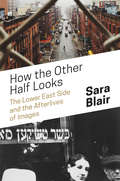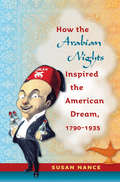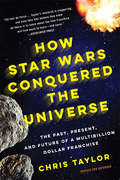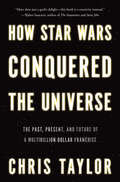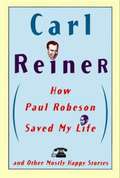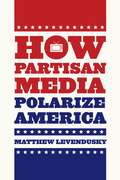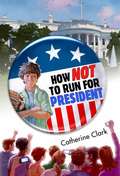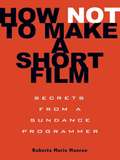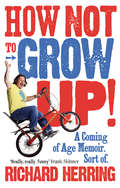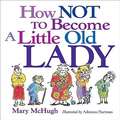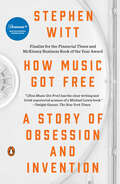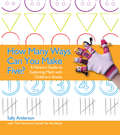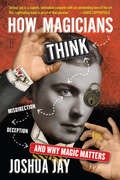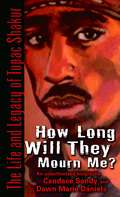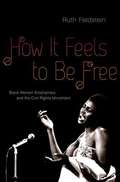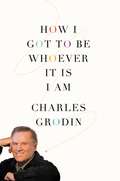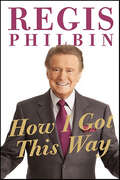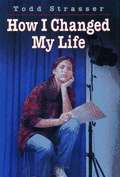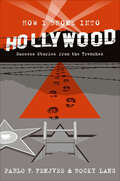- Table View
- List View
How the People Sang the Mountains Up: How and Why Stories
by Maria LeachThis book tells some of the most famous how and why stories, such as Why Rabbit has a Short Tail?, How the Horse was created?, and Why man has dogs? These stories are collected from around the world and in many different cultures. There is a bibliography and notes on the different stories. Delightful book for all ages.
How the Other Half Looks: The Lower East Side and the Afterlives of Images
by Sara BlairHow New York’s Lower East Side inspired new ways of seeing AmericaNew York City's Lower East Side, long viewed as the space of what Jacob Riis notoriously called the "other half," was also a crucible for experimentation in photography, film, literature, and visual technologies. This book takes an unprecedented look at the practices of observation that emerged from this critical site of encounter, showing how they have informed literary and everyday narratives of America, its citizens, and its possible futures.Taking readers from the mid-nineteenth century to the present, Sara Blair traces the career of the Lower East Side as a place where image-makers, writers, and social reformers tested new techniques for apprehending America--and their subjects looked back, confronting the means used to represent them. This dynamic shaped the birth of American photojournalism, the writings of Stephen Crane and Abraham Cahan, and the forms of early cinema. During the 1930s, the emptying ghetto opened contested views of the modern city, animating the work of such writers and photographers as Henry Roth, Walker Evans, and Ben Shahn. After World War II, the Lower East Side became a key resource for imagining poetic revolution, as in the work of Allen Ginsberg and LeRoi Jones, and exploring dystopian futures, from Cold War atomic strikes to the death of print culture and the threat of climate change.How the Other Half Looks reveals how the Lower East Side has inspired new ways of looking—and looking back—that have shaped literary and popular expression as well as American modernity.
How the Arabian Nights Inspired the American Dream, 1790-1935
by Susan NanceAmericans have always shown a fascination with the people, customs, and legends of the "East"--witness the popularity of the stories of theArabian Nights, the performances of Arab belly dancers and acrobats, the feats of turban-wearing vaudeville magicians, and even the antics of fez-topped Shriners. In this captivating volume, Susan Nance provides a social and cultural history of this highly popular genre of Easternized performance in America up to the Great Depression. According to Nance, these traditions reveal how a broad spectrum of Americans, including recent immigrants and impersonators, behaved as producers and consumers in a rapidly developing capitalist economy. In admiration of theArabian Nights, people creatively reenacted Eastern life, but these performances were also demonstrations of Americans' own identities, Nance argues. The story of Aladdin, made suddenly rich by rubbing an old lamp, stood as a particularly apt metaphor for how consumer capitalism might benefit each person. The leisure, abundance, and contentment that many imagined were typical of Eastern life were the same characteristics used to define "the American dream. " The recent success of Disney'sAladdinmovies suggests that many Americans still welcome an interpretation of the East as a site of incredible riches, romance, and happy endings. This abundantly illustrated account is the first by a historian to explain why and how so many Americans sought out such cultural engagement with the Eastern world long before geopolitical concerns became paramount.
How Sweet it is: the Jackie Gleason Story
by James BaconWritten with the full cooperation of the comedian and his family, this illustrated biography draws a portrait of the man who was one of television's first and biggest stars and who has had careers in clubs, film, and the theater as well.
How Star Wars Conquered The Universe: The Past, Present, And Future Of A Multibillion Dollar Franchise
by Chris TaylorIn 1973, a young filmmaker named George Lucas scribbled some notes for a far-fetched space-fantasy epic. Some forty years and $37 billion later, Star Wars-related products outnumber human beings, a growing stormtrooper army spans the globe, and "Jediism” has become a religion in its own right. Lucas’s creation has grown into far more than a cinematic classic; it is, quite simply, one of the most lucrative, influential, and interactive franchises of all time. Yet incredibly, until now the complete history of Star Wars--its influences and impact, the controversies it has spawned, its financial growth and long-term prospects--has never been told. In How Star Wars Conquered the Universe, veteran journalist Chris Taylor traces the series from the difficult birth of the original film through its sequels, the franchise’s death and rebirth, the prequels, and the preparations for a new trilogy. Providing portraits of the friends, writers, artists, producers, and marketers who labored behind the scenes to turn Lucas’s idea into a legend, Taylor also jousts with modern-day Jedi, tinkers with droid builders, and gets inside Boba Fett’s helmet, all to find out how Star Wars has attracted and inspired so many fans for so long. Since the first film’s release in 1977, Taylor shows, Star Wars has conquered our culture with a sense of lightness and exuberance, while remaining serious enough to influence politics in far-flung countries and spread a spirituality that appeals to religious groups and atheists alike. Controversial digital upgrades and poorly received prequels have actually made the franchise stronger than ever. Now, with a savvy new set of bosses holding the reins and Episode VII on the horizon, it looks like Star Wars is just getting started. An energetic, fast-moving account of this creative and commercial phenomenon, How Star Wars Conquered the Universe explains how a young filmmaker’s fragile dream beat out a surprising number of rivals to gain a diehard, multigenerational fan base--and why it will be galvanizing our imaginations and minting money for generations to come.
How Star Wars Conquered the Universe
by Chris TaylorHow did a few notes scribbled on a legal pad in 1973 by George Lucas, a man who hated writing, turn into a four billion dollar franchise that has quite literally transformed the way we think about entertainment, merchandizing, politics, and even religion? A cultural touchstone and cinematic classic, Star Wars has a cosmic appeal that no other movie franchise has been able to replicate. From Jedi-themed weddings and international storm-trooper legions, to impassioned debates over the digitization of the three Star Wars prequels, to the shockwaves that continue to reverberate from Disney’s purchase of the beloved franchise in 2012, the series hasn’t stopped inspiring and inciting viewers for almost forty years. Yet surprisingly little is known about its history, its impact#151;or where it’s headed next. In How Star Wars Conquered the Universe Chris Taylor unearths the human-scale stories that have gone into the making of this galactic-sized legend, and describes how and why Star Wars has been such an astonishing success. In a richly detailed narrative, Taylor traces the history of the series from its difficult birth through four drafts, a disastrous first cut, and many sequels and spin-offs. Today, he shows, Star Wars finds itself at a crossroads, with a new company holding the reins and a new trilogy looming on the horizon. Interspersing the story of Star Wars’ evolution with in-depth portraits of all the major names behind the films, as well as reportage about the franchise’s awesome cultural reach and its immensely lucrative business operations, Taylor shows that Star Wars has become ubiquitous: It is loved as much by children as adults, and as much by women as by men. Its action figures now outnumber human beings. And the films themselves have a reach that extends far beyond their viewership; even most so-called Star Wars #147;virgins” know that Darth Vader is Luke’s father, and can identify an Ewok (remarkable, considering that the creatures are never named in any of the Star Wars films). This incredible fertility of the Star Wars universe, Taylor explains, is reflected in its bottom line; the films’ merchandising revenue alone rivals the GDP of a small country. And with the series’ fandom only continuing to grow (despite the general consensus that the recent trilogy was an artistic failure), chances are good that Star Wars will still be galvanizing our imaginations#151;and minting money#151;for generations to come. An energetic, witty account of this stunning cinematic and business success story, How Star Wars Conquered the Universe is the saga of how a young filmmaker’s idle idea became such an immense, transformative cultural force.
How Star Wars Conquered the Universe
by Chris TaylorHow did a few notes scribbled on a legal pad in 1973 by George Lucas, a man who hated writing, turn into a four billion dollar franchise that has quite literally transformed the way we think about entertainment, merchandizing, politics, and even religion? A cultural touchstone and cinematic classic, Star Wars has a cosmic appeal that no other movie franchise has been able to replicate. From Jedi-themed weddings and international storm-trooper legions, to impassioned debates over the digitization of the three Star Wars prequels, to the shockwaves that continue to reverberate from Disney’s purchase of the beloved franchise in 2012, the series hasn’t stopped inspiring and inciting viewers for almost forty years. Yet surprisingly little is known about its history, its impact#151;or where it’s headed next. In How Star Wars Conquered the Universe Chris Taylor unearths the human-scale stories that have gone into the making of this galactic-sized legend, and describes how and why Star Wars has been such an astonishing success. In a richly detailed narrative, Taylor traces the history of the series from its difficult birth through four drafts, a disastrous first cut, and many sequels and spin-offs. Today, he shows, Star Wars finds itself at a crossroads, with a new company holding the reins and a new trilogy looming on the horizon. Interspersing the story of Star Wars’ evolution with in-depth portraits of all the major names behind the films, as well as reportage about the franchise’s awesome cultural reach and its immensely lucrative business operations, Taylor shows that Star Wars has become ubiquitous: It is loved as much by children as adults, and as much by women as by men. Its action figures now outnumber human beings. And the films themselves have a reach that extends far beyond their viewership; even most so-called Star Wars #147;virgins” know that Darth Vader is Luke’s father, and can identify an Ewok (remarkable, considering that the creatures are never named in any of the Star Wars films). This incredible fertility of the Star Wars universe, Taylor explains, is reflected in its bottom line; the films’ merchandising revenue alone rivals the GDP of a small country. And with the series’ fandom only continuing to grow (despite the general consensus that the recent trilogy was an artistic failure), chances are good that Star Wars will still be galvanizing our imaginations#151;and minting money#151;for generations to come. An energetic, witty account of this stunning cinematic and business success story, How Star Wars Conquered the Universe is the saga of how a young filmmaker’s idle idea became such an immense, transformative cultural force.
How Star Wars Conquered the Universe
by Chris TaylorHow did a few notes scribbled on a legal pad in 1973 by George Lucas, a man who hated writing, turn into a four billion dollar franchise that has quite literally transformed the way we think about entertainment, merchandizing, politics, and even religion? A cultural touchstone and cinematic classic, Star Wars has a cosmic appeal that no other movie franchise has been able to replicate. From Jedi-themed weddings and international storm-trooper legions, to impassioned debates over the digitization of the three Star Wars prequels, to the shockwaves that continue to reverberate from Disney’s purchase of the beloved franchise in 2012, the series hasn’t stopped inspiring and inciting viewers for almost forty years. Yet surprisingly little is known about its history, its impact--or where it’s headed next. In How Star Wars Conquered the Universe Chris Taylor unearths the human-scale stories that have gone into the making of this galactic-sized legend, and describes how and why Star Wars has been such an astonishing success. In a richly detailed narrative, Taylor traces the history of the series from its difficult birth through four drafts, a disastrous first cut, and many sequels and spin-offs. Today, he shows, Star Wars finds itself at a crossroads, with a new company holding the reins and a new trilogy looming on the horizon. Interspersing the story of Star Wars’ evolution with in-depth portraits of all the major names behind the films, as well as reportage about the franchise’s awesome cultural reach and its immensely lucrative business operations, Taylor shows that Star Wars has become ubiquitous: It is loved as much by children as adults, and as much by women as by men. Its action figures now outnumber human beings. And the films themselves have a reach that extends far beyond their viewership; even most so-called Star Wars "virgins” know that Darth Vader is Luke’s father, and can identify an Ewok (remarkable, considering that the creatures are never named in any of the Star Wars films). This incredible fertility of the Star Wars universe, Taylor explains, is reflected in its bottom li≠ the films’ merchandising revenue alone rivals the GDP of a small country. And with the series’ fandom only continuing to grow (despite the general consensus that the recent trilogy was an artistic failure), chances are good that Star Wars will still be galvanizing our imaginations--and minting money--for generations to come. An energetic, witty account of this stunning cinematic and business success story, How Star Wars Conquered the Universe is the saga of how a young filmmaker’s idle idea became such an immense, transformative cultural force.
How Paul Robeson Saved My Life and Other Stories
by Carl ReinerCarl Reiner has been making people laugh since the days of The Dick Van Dyke Show. His showbiz bits with Mel Brooks about the 2000 Year Old Man have become the stuff of comedy legend. Jerry Seinfeld, Alan Alda, Neil Simon, Steve Allen, and Richard Lewis were all bowled over by the comic genius of The 2000 Year Old Man in the Year 2000: The Book. Now, in his wonderful new book, Carl Reiner shows off the talent and humor that have made him a comedic superstar. Filled with rich, multidimensional tales, this collection of short stories from one of America's truly great comedic minds is at once poignant, nostalgic, and laugh-out-loud funny. "How Paul Robeson Saved My Life." the story of Reiner's experiences in the army during World War II, is a darkly funny look at racism. "Lance and Gwendolyn" is a modern-day fairy tale with some surprising twists. "Dial 411 for Legal Smut" is a tongue-in-cheek look at phone sex. Whatever topic he tackles, Reiner always manages to capture the highs and lows, the follies and foibles of everyday life.
How Partisan Media Polarize America
by Matthew LevenduskyForty years ago, viewers who wanted to watch the news could only choose from among the major broadcast networks, all of which presented the same news without any particular point of view. Today we have a much broader array of choices, including cable channels offering a partisan take. With partisan programs gaining in popularity, some argue that they are polarizing American politics, while others counter that only a tiny portion of the population watches such programs and that their viewers tend to already hold similar beliefs. <P><P> In How Partisan Media Polarize America, Matthew Levendusky confirms--but also qualifies--both of these claims. Drawing on experiments and survey data, he shows that Americans who watch partisan programming do become more certain of their beliefs and less willing to weigh the merits of opposing views or to compromise. And while only a small segment of the American population watches partisan media programs, those who do tend to be more politically engaged, and their effects on national politics are therefore far-reaching. <P>< In a time when politics seem doomed to partisan discord, How Partisan Media Polarize America offers a much-needed clarification of the role partisan media might play.
How Not To Run For President
by Catherine Clark"Humorous dialogue, smart pacing and some dirty politics make for an engaging read. With an election around the corner, this isn’t a bad way for young readers to view the political arena. "-Kirkus Reviews When the middle school band is called to play for a presidential campaign rally, Aidan is right there with his clarinet, just in time to save the candidate’s life. Interviewed by the media, he speaks up in favor of the need to save jobs-like his mom’s, for instance. Even though he’s in the middle of Little League season, for pete’s sake, the candidate convinces him to join her tour of the midwest. Problem 1: The candidate’s daughter HATES Aidan. Problem 2: What do you do when your whole life has been turned upside down and you can’t get away from the media? Problem 3: What’s a red-blooded American boy to do when he’s asked to play the clarinet on national TV and the local bully back home is giving interviews saying Aidan’s the nerd of the century?
How Not to Make a Short Film: Secrets from a Sundance Programmer
by Roberta Marie MunroeAnyone can make a short film, right? Just grab some friends and your handheld and you can do it in a weekend or two before being accepted to a slew of film festivals, right? Wrong. Roberta Munroe screened short film submissions at Sundance for five years, and is an award-winning short filmmaker in her own right. So she knows a thing or two about how not to make a short film. From the first draft of your script to casting, production, editing, and distribution, this is your one-stop primer for breaking into the business. Featuring interviews with many of today's most talented writers, producers, and directors, as well as revealing stories (e.g., what to do when the skinhead crack addict next door begins screaming obscenities as soon as you call "action") from the sets of her own short films, Roberta walks you through the minefield of mistakes that an aspiring filmmaker can make--so that you don't have to make them yourself.r breaking into the business. Featuring interviews with many of today's most talented writers, producers, and directors, as well as revealing stories (e.g., what to do when the skinhead crack addict next door begins screaming obscenities as soon as you call "action") from the sets of her own short films, Roberta walks you through the minefield of mistakes that an aspiring filmmaker can make--so that you don't have to make them yourself.
How Not to Grow Up: A Coming of Age Memoir. Sort of.
by Richard HerringComedian Richard Herring has a major problem. He's about to turn 40 and hasn't seen it coming. He's not married, doesn't have a proper job or 2.4 children. But now, finally, it looks as if the world expects him to be a grown up - and he's completely unprepared for it.As the momentous and terrifying event approaches (his birthday), Richard notices a steep decline in his own behaviour. Inexplicably he begins to behave more childishly - hanging out with 22-year-olds, developing an unhealthy addiction to Flumps and even getting into a ludicrous fight.How Not to Grow Up is the funny story of how a self-confessed perpetual Big Kid deals with his greatest fear - getting older - and is the perfect book for everyone who, deep down, still thinks that they're 18.
How Not to Become a Little Old Lady
by Mary MchughYou can be little, and you can be old, but that doesn't mean you have to be a Little Old Lady. We've all seen her. She's hunched forward, her blue hair is tucked neatly under a plastic rain bonnet, she's clutching expired coupons, and she's discussing her latest health problems over lunch. She's a Little Old Lady. . . and she's coming your way at two mph. Little Old Ladies have elastic waistbands on all their slacks. They save rubber bands, remember fifteen-cent McDonald's hamburgers, and have never seen a public rest room that was clean enough. How Not to Become a Little Old Lady is for any woman who is proud to have escaped Little Old Lady-hood, and it's for anyone in danger of slipping into those awful Little Old Lady tendencies.
How Music Got Free
by Stephen Witt"What happens when an entire generation commits the same crime?"How Music Got Free is a riveting story of obsession, music, crime, and money, featuring visionaries and criminals, moguls and tech-savvy teenagers. It's about the greatest pirate in history, the most powerful executive in the music business, a revolutionary invention and an illegal website four times the size of the iTunes Music Store. Journalist Stephen Witt traces the secret history of digital music piracy, from the German audio engineers who invented the mp3, to a North Carolina compact-disc manufacturing plant where factory worker Dell Glover leaked nearly two thousand albums over the course of a decade, to the high-rises of midtown Manhattan where music executive Doug Morris cornered the global market on rap, and, finally, into the darkest recesses of the Internet.Through these interwoven narratives, Witt has written a thrilling book that depicts the moment in history when ordinary life became forever entwined with the world online -- when, suddenly, all the music ever recorded was available for free. In the page-turning tradition of writers like Michael Lewis and Lawrence Wright, Witt's deeply-reported first book introduces the unforgettable characters--inventors, executives, factory workers, and smugglers--who revolutionized an entire artform, and reveals for the first time the secret underworld of media pirates that transformed our digital lives.An irresistible never-before-told story of greed, cunning, genius, and deceit, How Music Got Free isn't just a story of the music industry--it's a must-read history of the Internet itself.
How Music Got Free: The End of an Industry, the Turn of the Century, and the Patient Zero of Piracy
by Stephen WittFinalist for the 2016 Los Angeles Times Book Prize, the 2016 J. Anthony Lukas Book Prize, and the 2015 Financial Times and McKinsey Business Book of the YearA New York Times Editors' ChoiceONE OF THE YEAR'S BEST BOOKS: The Washington Post * The Financial Times * Slate * The Atlantic * Time * Forbes"[How Music Got Free] has the clear writing and brisk reportorial acumen of a Michael Lewis book."--Dwight Garner, The New York TimesWhat happens when an entire generation commits the same crime?How Music Got Free is a riveting story of obsession, music, crime, and money, featuring visionaries and criminals, moguls and tech-savvy teenagers. It's about the greatest pirate in history, the most powerful executive in the music business, a revolutionary invention and an illegal website four times the size of the iTunes Music Store. Journalist Stephen Witt traces the secret history of digital music piracy, from the German audio engineers who invented the mp3, to a North Carolina compact-disc manufacturing plant where factory worker Dell Glover leaked nearly two thousand albums over the course of a decade, to the high-rises of midtown Manhattan where music executive Doug Morris cornered the global market on rap, and, finally, into the darkest recesses of the Internet.Through these interwoven narratives, Witt has written a thrilling book that depicts the moment in history when ordinary life became forever entwined with the world online--when, suddenly, all the music ever recorded was available for free. In the page-turning tradition of writers like Michael Lewis and Lawrence Wright, Witt's deeply reported first book introduces the unforgettable characters--inventors, executives, factory workers, and smugglers--who revolutionized an entire artform, and reveals for the first time the secret underworld of media pirates that transformed our digital lives.An irresistible never-before-told story of greed, cunning, genius, and deceit, How Music Got Free isn't just a story of the music industry--it's a must-read history of the Internet itself.From the Hardcover edition.
How Many Zen Buddhists Does It Take to Screw in a Light Bulb?
by Matt Freedman Paul HoffmanExamples of the humor craze of the 1980s - the light bulb joke!
How Many Ways Can You Make Five?: A Parent's Guide to Exploring Math with Children's Books
by The Vermont Center for the Book Sally AndersonUse your child’s favorite books to explore and investigate the world of mathematics! In a world filled with patterns, shapes, sequences, and numbers – math is all around us. From an early age, children begin to notice and make connections between math concepts and everyday life, asking: How many? How high? How long? and How much does that weigh?Children’s books can bring math concepts to life. With the help of the stories and activities in How Many Ways Can You Make Five? you and your child will have a blast reading about, talking about, and exploring the world of math. Use favorite children’s books to investigate patterns and puzzles, learn how to subtract, and make maps.With four chapters that cover a multitude of themes, it’s never been easier to deepen your child’s understanding of important math and reading concepts at the same time!
How Magicians Think: Misdirection, Deception, and Why Magic Matters
by Joshua JayThe door to magic is closed, but it&’s not locked. And now Joshua Jay, one of the world&’s most accomplished magicians, not only opens that door but brings us inside to reveal the artistry and obsessiveness, esoteric history, and long-whispered-about traditions of a subject shrouded in mystery. And he goes one step further: Joshua Jay brings us right into the mind of a magician—how they develop their other worldly skills, conjure up illusions, and leave the rest of us slack jawed with delight time after time. Along the way, Jay reveals another kind of secret, one all readers will find meaningful even if they never aspire to perform sleight of hand: What does it take to follow your heart and achieve excellence? In 52 short, compulsively readable essays, Jay describes how he does it, whether it&’s through the making of illusions, the psychology behind them, or the way technology influences the world of magic. He considers the aesthetics of performance, discusses contemporary masters, including David Copperfield, Penn & Teller, and David Blaine, and details how magicians hone their craft. And answers questions like: Can a magic trick be too good? How do you saw a person in half? Is there real magic in the universe? The answers, like so much in magic and life, depend on you.
How Long Will They Mourn Me?: The Life and Legacy of Tupac Shakur
by Dawn Marie Daniels Candace Sandy"Buried as a g while tha whole world remembers me" -Tupac Shakur, from "Until the End of Time" Tupac Shakur was larger than life. A gifted rapper, actor, and poet, he was fearless, prolific, and controversial-and often said that he never expected to live past the age of thirty. He was right. On September 13, 1996, he died of gunshot wounds at age twenty-five. But even ten years after Tupac's tragic passing, the impact of his life and talent continues to flourish. Lauded as one of the greatest hip-hop artists of all time, Tupac has sold more than sixty-seven million records worldwide, making him the top-selling rapper ever. How Long Will They Mourn Me? celebrates Tupac's unforgettable life-his rise to fame; his tumultuous dark side marked by sex, drugs, and violence; and the indelible legacy he left behind. Although Tupac's murder remains unsolved, the spirit of this legendary artist is far from forgotten. How long will we mourn him? Fans worldwide will grieve his untimely death for a long time to come.
How it Feels to be Free: Black Women Entertainers and the Civil Rights Movement
by Ruth FeldsteinIn 1964 Nina Simone sat at a piano in New York's Carnegie Hall to play what she called a "show tune." Then she began to sing: "Alabama's got me so upset / Tennessee made me lose my rest / And everybody knows about Mississippi Goddam!" Simone, and her song, became icons of the civil rights movement. But her confrontational style was not the only path taken by black women entertainers. In How It Feels to Be Free, Ruth Feldstein examines celebrated black women performers, illuminating the risks they took, their roles at home and abroad, and the Ways that they raised the issue of gender amid their demands for black liberation. Feldstein focuses on six women who made names for themselves in the music, film, and television industries: Nina Simone, Lena Horne, Miriam Makeba, Abbey Lincoln, Diahann Carroll, and Cicely Tyson. These women did not simply mirror black activism; their performances helped constitute the era's political history. Makeba connected America's struggle for civil rights to the fight against apartheid in South Africa, while Simone sparked high-profile controversy with her incendiary lyrics. Yet Feldstein finds nuance in their careers. In 1968, Hollywood cast the outspoken Lincoln as a maid to a white family in For Love of Ivy, adding a layer of complication to the film. That same year, Diahann Carroll took on the starring role in the television series Julia. Was Julia a landmark for casting a black woman or for treating her race as unimportant? The answer is not clear-cut. Yet audiences gave broader meaning to what sometimes seemed to be apolitical performances. How It Feels to Be Free demonstrates that entertainment was not always just entertainment and that "We Shall Overcome" was not the only soundtrack to the civil rights movement. By putting black women performances at center stage, Feldstein sheds light on the meanings of black womanhood in a revolutionary time.
How I Got to Be Whoever It Is I Am
by Charles GrodinIn his candid and engaging new book HOW I GOT TO BE WHOEVER IT IS I AM, successful actor, author, and activist, Charles Grodin, looks back at the major events and private moments that have shaped his life. And, since Grodin is one of the best storytellers around, he can't help but entertain while offering insight gained from a wealth of experience. The combination of being impeached as class president by his fifth grade teacher (and then winning many school elections thereafter) with being thrown out of Hebrew School for asking too many questions (only to find a much better teacher as a result) informed Grodin's view of himself and made him adept at dealing with rejection--an important skill for an actor. Grodin's success in plays in high school and adventures in college theater led him to a career in acting, studying with the great teachers like Uta Hagen and Lee Strasberg. Grodin shares behind-the-scenes tales of working on plays like Same Time Next Year and movies like The Heartbreak Kid and Midnight Run--even how close he came to playing the lead in The Graduate.His stories feature the many actors, directors, writers, and producers, with whom he's worked, such as Robert DeNiro, Dustin Hoffman, Johnny Carson, Orson Welles, Warren Beatty, and other colorful characters. Grodin's greatest work isn't limited to stage and screen, however. He has been an award winning talk show host and commentator on Sixty Minutes II, and he reveals insights about the political and personal side of journalism and some of the larger-than-life characters he's interviewed. Still, it is the personal aspects of Grodin's life that are truly revealing and funny. He shares intimate anecdotes of humorous dating experiences during the carefree 70s along with stories of what it was like to be a young actor then with friends and colleagues like Robert Redford, Gene Wilder, and Dustin Hoffman. But it is Grodin's tales of the lives he's helped save with his relentless advocacy work that make you realize what a great guy Charles Grodin really is. We are lucky that the nice guy his friends call, "Chuck" brings us along to share a little of his journey of how he got to be who he really is!
How I Got This Way
by Regis PhilbinIn this entertaining memoir, the irrepressible "Reege" - consummate talk show host, man about town, loving husband, father, and yes, obsessive sports fan-looks back at his years in show business. One of the most popular television and cultural icons ever, Regis Philbin entertained television audiences for more than fifty years—as a beloved morning-show host (Live with Regis and Kelly), a nighttime game-show host (Who Wants to Be a Millionaire?) and also as a fixture on national and local late-night talk shows. The irrepressible “Reege” has regaled television audiences with his stories for more than half a century, but he’s saved the most hilarious, surprising, heartfelt, and inspiring tales for How I Got This Way. Both a fascinating show business memoir and a delightful primer for living the good life rolled into one, How I Got This Way is Reege being Reege, just the way we love him, as he shares the secrets to success and happiness that he has learned from his innumerable celebrity encounters, his close, personal friendships, and, of course, his relationship with his loving wife and family.
How I Changed My Life
by Todd StrasserA knee injury has left football star Kyle Winthrop sitting on the sidelines of high school life. Bolita Vine has vowed to change her image. She loses weight and works on becoming more assertive. She even lands the job of stage managing the school play. When Kyle tries out for the play, he and Bo become friends. But when Bo tries to take the relationship one step further, she soon learns the difference between fantasy and reality.
How I Broke into Hollywood: Success Stories from the Trenches
by Pablo F. Fenjves Rocky Lang“Inspiring…. Celebrity watchers will enjoy these vignettes, and Hollywood hopefuls will benefit from the advice.” — Library Journal“The collection of people ranges far and wide…buy it and take it with you to the beach.” — Filmstew.com

